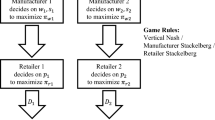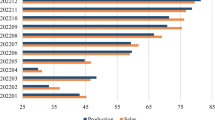Abstract
Under the subsidy and double credit policies, this paper constructs a competitive game model under the two situations of weak car enterprises without introducing technical service providers and introducing technical service providers, to explore the impact of subsidy threshold and dynamic integral coefficient on the green degree, profit, and environment of car enterprises’ products. The study found that when the strong car enterprises do not adopt the high R&D investment strategy, the weak car enterprises will not adopt the high R&D strategy. When strong car companies adopt high R&D investment strategy, it is more favorable for weak car companies to adopt high R&D investment strategy than low R&D strategy. For weak car enterprises, their competitive strength is the greatest when they introduce technical service providers and both strong and weak car enterprises adopt low green product strategy; the competitive strength is the smallest when the technology service provider is not introduced and the strong car enterprises adopt the high green product strategy; in other modes, the competitive strength of weak car enterprises is related to factors such as R&D cost coefficient, points of standard models of pure electric vehicles, and unit recovery income. The increase of points of standard models will weaken the innovation vitality in the chain. The decline of subsidies is more beneficial to the weak car enterprises, and the strong and weak car enterprises can effectively deal with the decline of subsidies when they adopt the high green product strategy.










Similar content being viewed by others
References
Breetz, H. L., & Salon, D. (2018). Do electric vehicles need subsidies? Ownership costs for conventional, hybrid, and electric vehicles in 14 US cities. Energy Policy, 120, 238–249.
Cao, X., Xing, Z. Y., & Zhang, L. P. (2018). Research on evolutionary game of cooperative innovation in new energy vehicle industry driven by government. Operations Research and Management, 027(006), 21–30.
Du, S. (2020). Intensified competition among Chinese new energy vehicle enterprises [J]. Automotive and Parts, 2020(19), 6.
Gu, H., Liu, Z., & Qing, Q. (2017). Optimal electric vehicle production strategy under subsidy and battery recycling. Energy Policy, 109, 579–589.
Guo, Q., Liao, H., Li, Z. L., et al. (2018). The impact of consumer social responsibility on the choice of low-carbon strategies. Industrial Engineering and Management, 23(2), 144–151.
Ji, S. F., Dan, Z., & Rong, J. L. (2019). Evolutionary game analysis on local governments and manufacturers’ behavioral strategies: Impact of phasing out subsidies for new energy vehicles. Energy, 189, 116064.
Kang, H. P. (2023). New energy vehicles enter the stage of competition with cost advantage and technological advantage as the core. Shanghai Automobile, 08, 1–3.
Kong, D., Xia, Q., Xue, Y., et al. (2020). Effects of multi policies on electric vehicle diffusion under subsidy policy abolishment in China: A multi-actor perspective. Applied Energy, 266, 114887.
Kong, Y., Wang, S., Jiao, Y. J., & Peng, D. H. (2021). Research on the impact of government subsidies on green innovation of new energy enterprises – From the perspective of Cournot competition. Inquiry into Economic Issues, 6, 71–81.
Li, L. (2018). The research on the impacts of government R&D subsidies on the technological innovation output of new energy vehicle industry [J]. Science and Technology Management Research, 17, 160–166.
Li, J., Ku, Y., Liu, C., et al. (2020). Dual credit policy: Promoting new energy vehicles with battery recycling in a competitive environment? [J]Journal of Cleaner Production, 243(10), 118456.1-118456.14
Liu, L. J., & Zhao, Z. H. (2016). Simulation of multi-agent innovation network operation mechanism after the withdrawal of financial subsidies-Taking new energy vehicles as an example. Scientific Research Management, 37(8), 58–66.
Liu, C., Huang, W., & Yang, C. (2017). The evolutionary dynamics of China’s electric vehicle industry-Taxes vs. subsidies. Computers & Industrial Engineering, 113(nov.), 103–122.
Liu, J., Nie, J. J., & Yuan, H. P. (2021). Competitive strategies for product research and development of new energy vehicle enterprises considering government subsidies and consumer environmental preferences [J]. Chinese Journal of Management, 18(08), 1245–1254.
Lu, C., & Yan, J. L. (2019). R&D game of duopoly new energy vehicle enterprises considering “double integral” transaction. Industrial Technology and Economy, 38(01), 67–73.
Ouchida, Y., & Goto, D. (2016). Cournot duopoly and environmental R&D under regulator’s precommitment to an emissions tax[J]. Applied Economics Letters, 23(5), 324–331.
Qin, Z. X. (2017). Analysis of subsidy strategies against strategic emerging industries characterized by innovation driving mode. Operations Research and Management Science, 26(10), 173–180.
Rao, Y. B., & Shu, T. (2023). Analysis of technological innovation behavior of new energy vehicle enterprises based on China’s dual credit policy. Management Review, 35(07), 74–85.
Shang, H. T., & Song, Y. X. (2020). Dynamic incentive effect of government environmental R&D subsidies for Chinese new energy enterprises. Science & Technology Progress and Policy, 22, 65–72.
Shao, L., Yang, J., & Min, Z. (2017). Subsidy scheme or price discount scheme? Mass adoption of electric vehicles under different market structures. European Journal of Operational Research, 262(3), 1181–1195.
Shao, W., Yang, K., & Liang, J. (2018). Government subsidies, R&D incentives and new energy vehicles innovation. Science & Technology Progress and Policy, 15, 69–75.
Shi, D., & Ming, X. (2023). Can the “dual points” policy promote substantial innovation in new energy vehicles? Journal of Beijing Institute of Technology (social Sciences Edition), 25(04), 40–51.
Sun, J. G., & Tian, M. F. (2023). Does the dual credit policy promote the “simultaneous improvement of quantity and quality” of innovation in new energy vehicle enterprises? Soft Science, 15, 952.
Sun, X., Liu, X., Wang, Y., et al. (2019a). The effects of public subsidies on emerging industry: An agent-based model of the electric vehicle industry. Technological Forecasting and Social Change, 140, 281–295.
Sun, X. H., Liu, X. L., Yun, W., & Fang, Y. (2019b). The effects of public subsidies on emerging industry: An agent based model of the electric vehicle industry. Technological Forecasting and Social Change, 140(3), 281–295.
Wang, Q. M., Han, Q. M., & Yang, C. (2014). Government subsidies and corporate behavior in strategic emerging industries: A perspective of dynamic game based on government regulation. Journal of Finance and Economics, 40(7), 43–53.
Wen, X. Q., Cheng, H. F., Cai, J. H., et al. (2018). Government subsidy strategy and effect analysis in green supply chain. Chinese Journal of Management, 15(04), 625–632.
Wu, Y., Gu, F., Ji, Y., et al. (2020). Technological capability, eco-innovation performance, and cooperative R&D strategy in new energy vehicle industry: Evidence from listed companies in China. Journal of Cleaner Production, 261, 121157.
Xiong, Y. Q., Fan, S. W., & Liu, X. Y. (2018). The difference of fiscal subsidies for new energy vehicles and R&D investment intensity of the manufacturers: An analysis based on the heterogeneity of the manufacturer’s strategic decision. Science of Science and Management of s.&t., 39(6), 72–83.
Yang, D. X., Qiu, L. S., Yan, J. J., et al. (2019). The government regulation and market behavior of the new energy automotive industry. Journal of Cleaner Production, 210, 1281–1288.
Yu, F., Wang, L., & Li, X. (2020). The effects of government subsidies on new energy vehicle enterprises: The moderating role of intelligent transformation. Energy Policy, 141, 111463.
Zhao, H., & Zheng, J. C. (2019). Impact of different subsidy policies for new energy vehicles on market stability. Chinese Journal of Management Science, 27(9), 47–55.
Zheng, J. C., Zhao, H., & Li, Z. G. (2019a). Research on R&D subsidies for new energy vehicle industry under the double credit policy. Scientific Research Management, 40(02), 126–133.
Zheng, G. H., Li, H. L., & Pan, B. (2019b). A Comparative study on the influence of finance and taxation policy to R&D input of new energy automobile industry. Financial Theory and Practice, 40(4), 101–106.
Zhou, W., & Huang, W. (2016). Contract designs for energy-saving product development in a monopoly[J]. European Journal of Operational Research, 250(3), 902–913.
Zhu, W., & He, Y. (2017). Green product design in supply chains under competition [J]. European Journal of Operational Research, 258(1), 165–180.
Funding
This study is sponsored by the Consulting Research Project of Chinese Academy of Engineering (2019SX2), Key Projects of NSFC (U1710258).
Author information
Authors and Affiliations
Corresponding author
Ethics declarations
Conflict of Interest
The authors declare no competing interests.
Additional information
Publisher's Note
Springer Nature remains neutral with regard to jurisdictional claims in published maps and institutional affiliations.
Appendix
Appendix
Rights and permissions
Springer Nature or its licensor (e.g. a society or other partner) holds exclusive rights to this article under a publishing agreement with the author(s) or other rightsholder(s); author self-archiving of the accepted manuscript version of this article is solely governed by the terms of such publishing agreement and applicable law.
About this article
Cite this article
Li, Jx., Li, Jz. & Wu, Yc. Product R&D Strategy of New Energy Vehicle Enterprises Embedded with Technical Services Under the Subsidy Threshold. J Knowl Econ (2024). https://doi.org/10.1007/s13132-024-01810-6
Received:
Accepted:
Published:
DOI: https://doi.org/10.1007/s13132-024-01810-6




